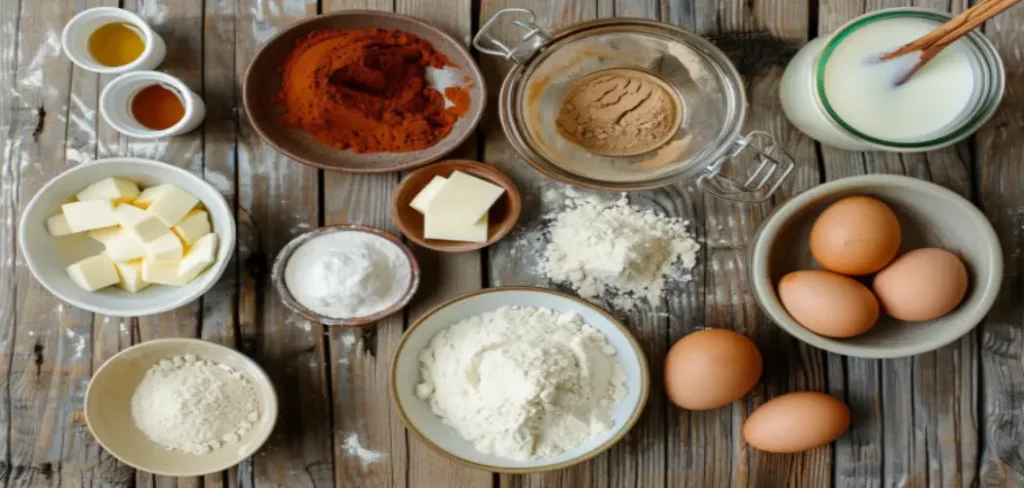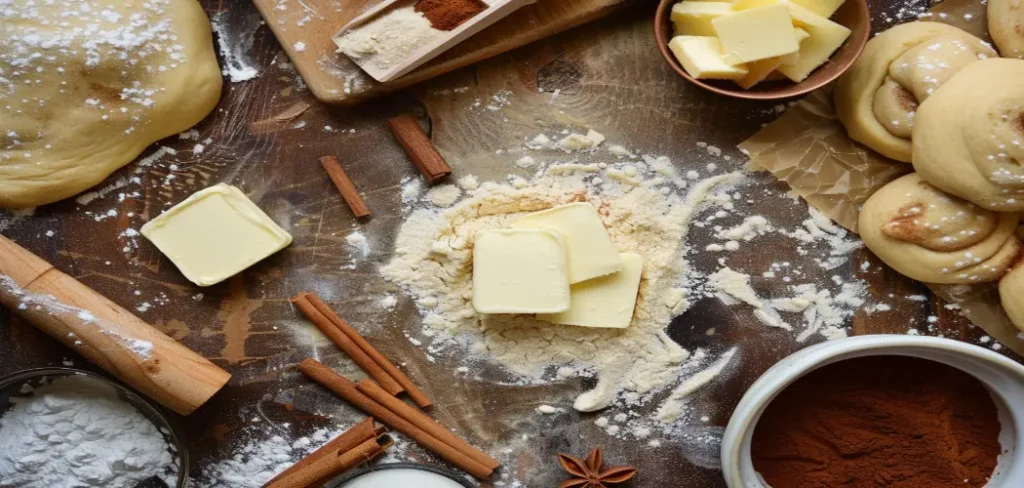Cinnamon rolls are a beloved treat, known for their soft, fluffy texture and rich, sweet flavor. When made with a sourdough starter, they take on a new depth of flavor, offering a slightly tangy undertone that balances perfectly with the sweet cinnamon filling and creamy frosting. Using a sourdough starter not only makes the rolls more flavorful, but it also gives them a unique texture that can’t be replicated with commercial yeast. So the question is how to make cinnamon rolls with a sourdough starter.
In this guide, we’ll walk you from preparing the dough to rolling out the perfect cinnamon swirls. We’ll also share tips on fermenting the dough, shaping the rolls, and ensuring they come out of the oven perfectly golden and delicious. Let’s explore the process of creating these indulgent, homemade rolls with the extra flavor boost of sourdough.
What Is a Sourdough Starter?
A sourdough starter is a naturally fermented mixture of flour and water that serves as a leavening agent in baking. Unlike commercial yeast, which produces quick rises, a sourdough starter relies on wild yeast and bacteria to ferment the dough more slowly. This longer fermentation process enhances the depth of flavor and results in a more complex, chewy texture. In the case of cinnamon rolls, this leads to a subtle tanginess that balances the sweetness of the cinnamon-sugar filling.
The fermentation process in a sourdough starter begins when you combine flour and water, creating an environment where wild yeast (naturally occurring in the air and flour) can thrive. As the yeast consumes the sugars in the flour, it produces carbon dioxide and alcohol, which causes the dough to rise. The bacteria in the starter, particularly lactobacillus, also play a crucial role by creating lactic acid, which gives sourdough its characteristic tangy flavor.
When using a sourdough starter for cinnamon rolls, the key is ensuring the starter is active and bubbly. An active starter will contain enough wild yeast to help your dough rise properly, ensuring the cinnamon rolls are light, fluffy, and perfectly airy. If the starter isn’t fully active, your dough may not rise well, leading to dense rolls.
The beauty of using a sourdough starter lies in the flavor development. While traditional cinnamon rolls are deliciously sweet, sourdough cinnamon rolls offer an added layer of complexity. The tang from the fermentation process contrasts beautifully with the rich butter and sugar, giving the rolls an irresistible, unique taste.
If you don’t have a sourdough starter yet, you can create your own by mixing equal parts flour and water and letting it ferment over several days, feeding it daily to keep it active. For a detailed guide on making your own sourdough starter, you can explore tutorials available online.
Ingredients Needed for Sourdough Cinnamon Rolls

To make the perfect batch of sourdough cinnamon rolls, you’ll need a combination of staple baking ingredients and, of course, a healthy, active sourdough starter. Here’s a breakdown of everything you’ll need to get started.
The Dough:
- 1 cup active sourdough starter: Your sourdough starter must be bubbly and fully active to ensure proper rising. If your starter has been in the fridge, be sure to feed it several hours before using it in the recipe.
- 3 cups all-purpose flour: All-purpose flour works well, but you can also use bread flour for a slightly chewier texture. The protein content in bread flour will help create a stronger dough, making it easier to roll out.
- 1/4 cup sugar: This adds a touch of sweetness to the dough itself. You can use granulated sugar, but some bakers prefer adding a mix of white and brown sugar for a richer flavor.
- 1/2 cup milk: Warm milk helps activate the yeast in the starter, making the dough more tender. You can use whole milk for richness, or substitute with a non-dairy milk like almond, oat, or soy.
- 1/4 cup softened butter: Butter adds moisture and richness to the dough, making the rolls softer and more flavorful.
- 1 large egg: The egg helps bind the dough and provides structure, leading to a tender crumb.
- 1 teaspoon salt: Salt enhances the flavor of the dough and balances the sweetness. It also strengthens the gluten structure, helping the dough rise evenly.
Cinnamon Filling:
- 1/2 cup softened butter: The butter acts as the base for the cinnamon-sugar mixture and ensures the filling stays moist and flavorful.
- 1/2 cup brown sugar: Brown sugar provides a deeper, caramel-like sweetness compared to granulated sugar. You can use light or dark brown sugar depending on your preference for sweetness intensity.
- 2 tablespoons ground cinnamon: Cinnamon is the star of the filling. For a stronger flavor, you can add an extra tablespoon or mix it with other spices like nutmeg or cardamom for a unique twist.
Cream Cheese Frosting:
- 4 oz cream cheese (softened): Cream cheese creates a tangy, smooth frosting that complements the sourdough cinnamon rolls.
- 1 cup powdered sugar: Powdered sugar sweetens the frosting while maintaining a smooth consistency. You can adjust the amount depending on how sweet you like your frosting.
- 1 teaspoon vanilla extract: Vanilla enhances the flavor of the frosting, making it more aromatic and balanced.
Tips:
- Make sure your sourdough starter is fully active and bubbly before incorporating it into the dough. This will ensure your dough rises properly.
- For a richer dough, you can substitute some of the milk with heavy cream, adding extra moisture and softness to the rolls.
- Always let your butter and cream cheese soften at room temperature before mixing to achieve a smooth consistency.
Step-by-Step Guide to Making the Dough
Making the dough is the most crucial step in ensuring your sourdough cinnamon rolls turn out soft and fluffy. Here’s a detailed guide on how to create the perfect dough from start to finish.
Step 1: Mixing the Dough
Start by combining your wet ingredients. In a large mixing bowl, add 1 cup of active sourdough starter, 1/2 cup warm milk, and 1/4 cup softened butter. Stir the mixture until everything is well combined. The butter should be soft enough to blend in easily, ensuring a smooth dough.
Next, whisk in 1 large egg, 1/4 cup sugar, and 1 teaspoon salt. Mixing the egg at this stage helps incorporate the fat and liquid components evenly. The sugar will sweeten the dough just slightly, while the salt balances the flavors.
Once the wet ingredients are fully mixed, begin adding 3 cups of all-purpose flour, 1 cup at a time. Stir the flour into the wet ingredients with a wooden spoon or spatula. After all the flour is added, the dough should begin to come together, but it will still be sticky and a bit loose at this stage.
Step 2: Kneading the Dough
Turn the dough out onto a lightly floured surface and begin kneading it by hand. The goal is to develop the gluten, which will give the dough structure and elasticity. Knead for about 5 to 7 minutes, adding small amounts of flour as needed to keep the dough from sticking to your hands or the surface.
You’ll know the dough is ready when it becomes smooth and elastic. If you press the dough with your finger, it should slowly bounce back, indicating it’s developed enough structure to rise properly. The dough should still feel slightly tacky but not overly sticky.
If you have a stand mixer, you can use the dough hook attachment to knead the dough for about 5 minutes on medium speed. This will save time and ensure even gluten development.
Step 3: Letting the Dough Rise
Once your dough is kneaded, transfer it to a greased bowl, cover it with plastic wrap or a damp cloth, and let it rise at room temperature for about 4 to 6 hours. The dough needs this time to ferment and develop flavor from the sourdough starter.
For an even deeper flavor, you can let the dough rise in the refrigerator overnight. This slow fermentation method not only improves the flavor but also allows for more flexibility in your baking schedule. The dough will rise more slowly in the fridge, so don’t worry if it hasn’t doubled in size by morning. If refrigerating overnight, let the dough sit at room temperature for about 1 hour before rolling it out.
The dough is ready for the next step when it has doubled in size and feels soft and airy to the touch. If it’s not quite there after the initial rise, give it another hour or two until it’s ready.
Step 4: Rolling Out the Dough
Once the dough has risen, lightly punch it down to release any large air bubbles. Turn the dough onto a floured surface and use a rolling pin to roll it out into a large rectangle, about 1/4 inch thick. Try to maintain an even thickness throughout the dough, as this will ensure consistent baking.
The rectangle should be large enough to hold your cinnamon filling but not so thin that it tears when you roll it up. Rolling the dough evenly is key to achieving those perfect swirls in your cinnamon rolls.
At this point, your dough is ready to be filled, rolled, and shaped into delicious cinnamon rolls.
Making the Cinnamon Filling

The filling is the heart of your cinnamon rolls, giving them that signature sweet, spicy flavor. Here’s how to prepare the cinnamon filling and spread it over the dough.
Step 1: Prepare the Cinnamon-Sugar Mixture
In a small bowl, combine 1/2 cup softened butter, 1/2 cup brown sugar, and 2 tablespoons ground cinnamon. Make sure the butter is soft enough to mix easily with the sugar and cinnamon. Use a spoon or spatula to thoroughly blend the mixture until smooth. You want the cinnamon and sugar to be evenly distributed throughout the butter for consistent flavor in each bite.
If you prefer a more intense filling, feel free to increase the amount of cinnamon or add a pinch of nutmeg or cardamom for additional spice complexity.
Step 2: Spread the Filling
Once your dough is rolled out into a rectangle, it’s time to spread the filling. Using an offset spatula or the back of a spoon, gently spread the cinnamon-sugar mixture over the surface of the dough. Be sure to cover the dough evenly, leaving a small border (about 1/2 inch) along the edges to prevent the filling from leaking out when rolling.
Make sure to get the filling all the way to the edges of the dough, especially the sides. This ensures that each cinnamon roll is packed with flavor.
Optional Additions
For added texture, you can sprinkle chopped nuts, like pecans or walnuts, over the filling before rolling the dough. Raisins or chocolate chips are also great additions if you want a sweeter, more decadent roll.
With the filling in place, you’re ready to roll up the dough and cut it into perfect cinnamon rolls.
Shaping and Cutting the Cinnamon Rolls

Once the dough is filled with the cinnamon-sugar mixture, it’s time to shape and cut the rolls. Here’s how to ensure they come out uniform and well-shaped.
Step 1: Rolling the Dough
Starting from one of the long edges of your dough rectangle, carefully roll the dough into a tight log. Roll slowly and evenly to ensure that the filling stays inside and is evenly distributed throughout the roll. As you roll, make sure the log is firm but not too tight, as this can cause the rolls to burst during baking.
Once you reach the end, pinch the seam to seal it shut. This keeps the filling from spilling out and helps maintain the roll’s shape.
Step 2: Cutting the Rolls
Using a sharp knife or unflavored dental floss, cut the dough log into even slices, about 1 to 1.5 inches thick. Dental floss is a great tool for cutting cinnamon rolls, as it allows for clean cuts without squashing the dough. To do this, slide the floss under the dough log, cross the ends over the top, and pull them through to slice.
Aim for 12 to 15 rolls from the dough, depending on how thick you want each roll to be.
Step 3: Arranging the Rolls in the Pan
Place the sliced rolls in a greased baking pan, leaving a small amount of space between them to allow for expansion as they rise. For a softer roll, use a round or square pan where the rolls can touch each other as they bake. If you prefer slightly crispier edges, leave more space between each roll on the pan.
At this point, you’ll need to allow the rolls to rise for a second time. Cover the pan loosely with plastic wrap and let them rise for about 1 to 2 hours until they have puffed up and nearly doubled in size.
Baking the Sourdough Cinnamon Rolls
After your rolls have risen for the second time, it’s finally time to bake them. Here’s how to get perfectly golden, soft sourdough cinnamon rolls.
Step 1: Preheat the Oven
Preheat your oven to 375°F (190°C). Preheating ensures that the oven reaches the right temperature before you put the rolls in, allowing them to bake evenly and develop a golden crust.
Step 2: Bake the Cinnamon Rolls
Once the oven is preheated, place your pan of risen cinnamon rolls on the center rack and bake for 20 to 25 minutes. Keep a close eye on them in the final few minutes, as you want them to be golden on top but not overly browned.
The tops should be lightly golden, and the centers should be soft but cooked through. If you’re unsure, you can insert a toothpick into the center of one of the rolls—it should come out clean or with just a few crumbs when they are done.
Step 3: Let the Rolls Cool
Once baked, remove the rolls from the oven and let them cool in the pan for about 5 minutes. This brief cooling period allows the rolls to set slightly before adding the frosting, ensuring the frosting doesn’t melt completely.
Making the Cream Cheese Frosting
No cinnamon roll is complete without a generous layer of cream cheese frosting. Here’s how to make the perfect frosting to spread over your warm sourdough cinnamon rolls.
Step 1: Prepare the Ingredients
To make the frosting, you’ll need:
- 4 oz cream cheese (softened)
- 1 cup powdered sugar
- 1 teaspoon vanilla extract
- 2 tablespoons milk or cream
Make sure the cream cheese is softened to room temperature so it blends easily with the powdered sugar.
Step 2: Mix the Frosting
In a medium-sized bowl, beat the softened cream cheese and powdered sugar together until smooth and fluffy. Add the vanilla extract and milk (or cream), and continue mixing until the frosting is smooth and spreadable. You can adjust the consistency by adding more milk if needed.
For a tangier frosting, you can increase the amount of cream cheese, or for a sweeter version, add extra powdered sugar.
Step 3: Frost the Cinnamon Rolls
While the cinnamon rolls are still slightly warm, generously spread the cream cheese frosting over the tops. The warmth of the rolls will cause the frosting to melt just a bit, seeping into the rolls and making them extra gooey.
Tips for Storing and Reheating Sourdough Cinnamon Rolls
If you have leftovers (though that’s rare!), you’ll want to know how to store and reheat your sourdough cinnamon rolls properly.
Storing the Cinnamon Rolls
To keep the cinnamon rolls soft, store them in an airtight container at room temperature for up to 2 days. If you want to keep them fresh for longer, you can store them in the fridge for up to 5 days. Make sure to cover them tightly to prevent them from drying out.
Reheating the Rolls
To reheat, place a cinnamon roll in the microwave for 15 to 20 seconds or until warmed through. You can also reheat them in the oven at 300°F (150°C) for about 10 minutes. If reheating from the fridge, you may want to cover the rolls with foil to prevent them from drying out.
Freezing the Rolls
If you want to freeze the cinnamon rolls, wrap each roll individually in plastic wrap and store them in an airtight container or freezer bag. They can be frozen for up to 3 months. To enjoy, thaw overnight in the fridge and reheat as mentioned above.
FAQ
How long does it take to make sourdough cinnamon rolls?
Sourdough cinnamon rolls take longer than traditional cinnamon rolls because of the extended fermentation process. The entire process, including the first rise and second rise, can take anywhere from 8 to 12 hours, depending on the temperature of your kitchen. If you let the dough rise overnight, the timeline can be more flexible.
Can I use a sourdough starter that’s not fully active?
It’s best to use a fully active, bubbly sourdough starter when making cinnamon rolls. If your starter isn’t active, the dough may not rise properly, resulting in dense rolls. Make sure to feed your starter a few hours before using it to ensure it’s at peak activity.
How do I know when my sourdough starter is ready to use?
Your sourdough starter is ready to use when it’s doubled in size, full of bubbles, and has a slightly tangy smell. A good test is the float test—drop a small spoonful of starter into a glass of water. If it floats, it’s ready to use.
Can I make these cinnamon rolls without the cream cheese frosting?
Yes! While the cream cheese frosting adds an extra layer of flavor, you can skip it if you prefer a lighter roll. Alternatively, you can top the rolls with a simple glaze made of powdered sugar and milk.
How do I adjust the recipe for a quicker rise?
To speed up the rising process, you can increase the temperature of your kitchen or use a proofing drawer. However, keep in mind that the longer, slower rise is what develops the flavor in sourdough, so rushing the process might affect the taste.
Conclusion
Now you know how to make cinnamon rolls with sourdough starter! The process might take a bit longer than traditional cinnamon rolls, but the reward is well worth the wait. The sourdough starter adds a unique depth of flavor and makes the rolls soft, fluffy, and slightly tangy. From mixing the dough to spreading the cinnamon-sugar filling and topping it off with cream cheese frosting, these rolls are a delicious treat for any occasion.
Whether you’re an experienced sourdough baker or new to working with starters, this recipe is a perfect way to expand your baking skills and enjoy something truly special. Give these sourdough cinnamon rolls a try, and enjoy the delightful combination of sweet, buttery, and tangy flavors in every bite!
